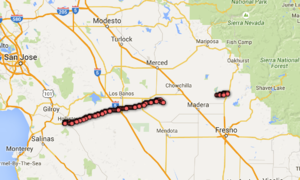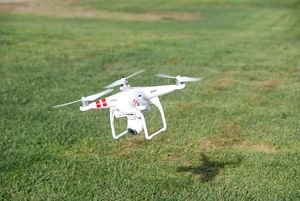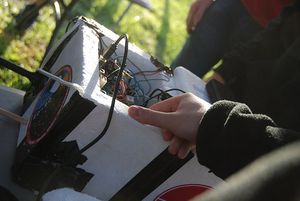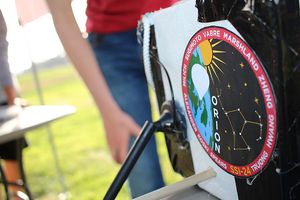Difference between revisions of "SSI-24"
Ehillstrom (talk | contribs) (Fixed external link (should not specify URL in text)) |
|||
| (14 intermediate revisions by 2 users not shown) | |||
| Line 5: | Line 5: | ||
| launch site = 2093 San Juan Drive, Hollister, CA | | launch site = 2093 San Juan Drive, Hollister, CA | ||
| launch coordinates = 36.84842,-121.43236 | | launch coordinates = 36.84842,-121.43236 | ||
| − | | | + | | flight duration = 3 hours, 44 minutes, 11.1 seconds |
| − | | | + | | landing date = October 24th, 2015, 3:23:11 PM PDT |
| last = 23 | | last = 23 | ||
| next = 25 | | next = 25 | ||
| Line 12: | Line 12: | ||
SSI-24 Orion was one of three balloons launched during fall quarter, 2015. It consisted of an almost all-freshman team dedicated to creating a scientifically power yet aesthetically beautiful payload. Ultimately, Orion represented a resounding success in its use of sensors, logging of data, power management, use of solar energy to charge its batteries, demonstration of wifi transmissions, and creation of a visually refined payload. The total ground track was 121.21 miles, and the top speed reached was 92.44 miles per hour. | SSI-24 Orion was one of three balloons launched during fall quarter, 2015. It consisted of an almost all-freshman team dedicated to creating a scientifically power yet aesthetically beautiful payload. Ultimately, Orion represented a resounding success in its use of sensors, logging of data, power management, use of solar energy to charge its batteries, demonstration of wifi transmissions, and creation of a visually refined payload. The total ground track was 121.21 miles, and the top speed reached was 92.44 miles per hour. | ||
| + | |||
| + | SSI-24 also launched the infamous [[SSI-Guy | SSGuy]] or SSI-Guy. | ||
== Pre-Launch == | == Pre-Launch == | ||
| Line 19: | Line 21: | ||
== Flight == | == Flight == | ||
| − | SSI-24 used the | + | [[File:SSI24 map.png | thumb | <center>SSI 24 ground track. The GPS was likely deactivated above 60,000 feet due to poor firmware implementation.</center>]] |
| + | |||
| + | SSI-24 used the [http://habmc.stanfordssi.org/#/app/spot_four|SPOT Nebula] for tracking and recovery. A Phantom 2 UAV was used by members of Orion to video the launch of SSI-23a, 23, 24, and 25. | ||
| Line 33: | Line 37: | ||
[[File:OrionWifi.jpg | thumb | <center> Wifi Antenna </center>]] | [[File:OrionWifi.jpg | thumb | <center> Wifi Antenna </center>]] | ||
| + | |||
| + | == Landing Drama == | ||
| + | |||
| + | Upon landing, SSI-24 was discovered by two passers-by. They kindly brought it to their home and phoned the balloons team, who recovered it soon after. | ||
== Milestones == | == Milestones == | ||
Latest revision as of 18:28, 9 December 2015
| SSI-24 (Orion) | ||||
|---|---|---|---|---|
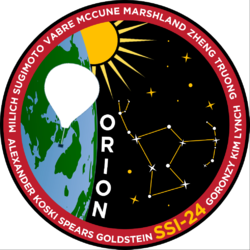
| ||||
| Launch date | October 24th, 2015, 11:39AM PDT | |||
| Launch site | 2093 San Juan Drive, Hollister, CA | |||
| Launch coordinates | 36.84842,-121.43236 | |||
| Flight duration | 3 hours, 44 minutes, 11.1 seconds | |||
| ||||
SSI-24 Orion was one of three balloons launched during fall quarter, 2015. It consisted of an almost all-freshman team dedicated to creating a scientifically power yet aesthetically beautiful payload. Ultimately, Orion represented a resounding success in its use of sensors, logging of data, power management, use of solar energy to charge its batteries, demonstration of wifi transmissions, and creation of a visually refined payload. The total ground track was 121.21 miles, and the top speed reached was 92.44 miles per hour.
SSI-24 also launched the infamous SSGuy or SSI-Guy.
Pre-Launch
The Pre-Launch proceeded fairly well with few hiccups. After fixing minor problems with the solar panel wiring, the team prepared the gimbal and finished visual preparation of the payload. Unfortunately, the team experienced extreme difficulties setting up the keychain camera (which did not function during flight). The payload, which consisted of two styrofoam boxes and a selfie stick, was attached to a single 1500g balloon.
Flight
SSI-24 used the Nebula for tracking and recovery. A Phantom 2 UAV was used by members of Orion to video the launch of SSI-23a, 23, 24, and 25.
Experimental Payload
SSI-24 included both a Raspberry Pi 2B and two Arduino Uno boards. The Raspberry Pi was initially intended to be used to stream live video from the balloon, however, due to issues with the camera board, it was simply used as a wifi access point. The two Arduino boards regulated the sensors onboard the balloon, including a temperature sensor, two heating pads, an SD reader, a GPS, a solar panel, and an accelerometer. Though the group initially intended to use a PIXY camera as well, the PIXY's requirement to be updated with signatures made it difficult to use aboard the balloon.
The second board served a single purpose: dropping three Hershey's chocolate bars at a specified altitude. This was accomplished using the GPS altitude from the first Arduino, which would set a single digital pin to high. This would trigger the second Arduino to swing a servo and release the bars.
Landing Drama
Upon landing, SSI-24 was discovered by two passers-by. They kindly brought it to their home and phoned the balloons team, who recovered it soon after.
Milestones
- First use of wifi antennas and Raspberry Pi on an SSI high altitude balloon
- Successful implementation of a gimbal for the SPOT GPS
| Balloon Launches | |
|---|---|
| 2014-15 | SSI-19 • 20 • 21 • 22 |
| 2015-16 | SSI-23(a) • 24 • 25 • 26 • 27 • 28 • 29 • 30 • 31 • 32 • 33 • 34 • 35 • 36 • 37 • 38 • 39 • 40 • 41 • 42 • 43 |
| 2016-17 | 44 • 45 • 46 • 47 • 48 • 49 • 50 • 51 • 52 |
| 2017-18 | |
| 2018-19 | 83 • 86 • 87 • 90 • 91 |
| 2019-20 | 92 • 93 • 97 |
| V • E | |
